Main menu
Common skin conditions

NEWS
Join DermNet PRO
Read more
Quick links
Cryotherapy — extra information
Cryotherapy
Author: Dr Amanda Oakley, Dermatologist, New Zealand, 1997. Updated by: Dr Jacqueline Kim Nguyen, Resident, St Vincent’s Hospital, Australia. Copy edited by Gus Mitchell. August 2022
Introduction
Uses
Contraindications
How it works
Benefits and disadvantages
Side-effects and complications
Post-treatment care
What is cryotherapy?
Cryotherapy is a minimally-invasive treatment that freezes skin surface lesions using extremely cold liquid or instruments (cryogen).
Cryotherapy, also known as cryosurgery or cryoablation, can be delivered with various cryogens. Liquid nitrogen is the most common and effective cryogen for clinical use (temperature –196°C).
Other cryogens include:
- Carbon dioxide snow (–78.5°C)
- Dimethyl ether and propane or DMEP (–57°C).
Cryotherapy is an effective alternative to more invasive treatment options as it is inexpensive, simple, relatively safe, and can be performed quickly in an outpatient setting.
What is cryotherapy used for?
Benign lesions that may be treated by cryotherapy include:
Dermatologists can freeze small skin cancers such as superficial basal cell carcinoma (BCC) and in-situ squamous cell carcinoma (SCC) on the trunks and limbs, but this is not always successful, so careful follow-up is necessary.
What are the contraindications with cryotherapy?
Cryotherapy should not be used for:
- Undiagnosed skin lesions
- Melanoma
- Dark-skinned patients
- Lesions which require tissue pathology
- Lesions within a circulation-compromised area
- Patients with previous adverse reactions to cryotherapy or unable to accept side effects
- Young children
- Unconscious patients
- Conditions exacerbated by cold exposure:
How does cryotherapy work?
Cryotherapy works by using a cryogen to cool the targeted lesion to sub-zero temperatures causing direct tissue necrosis. The thawing process induces osmolarity changes which also results in tissue damage.
Liquid nitrogen
Cryotherapy using liquid nitrogen involves the use of a cryospray, cryoprobe, or a cotton-tipped applicator. The dose, freeze-time, and delivery method depend on the location, depth, size, and tissue type of the lesion.
Liquid nitrogen spray methods include:
- Timed spot freeze technique/direct spray technique (standard treatment)
- Paintbrush method
- Rotary or spiral spray.
With the timed spot freeze technique, the spray gun is positioned 1 to 1.5cm above the centre of the skin lesion and sprayed until an ice ball encompasses the lesion (and required margin). The ice field is then maintained for 5 to 30 seconds depending on the lesion and depth of freeze. The treatment is repeated in some cases once thawing has completed. This is known as a ‘double freeze-thaw’.

A liquid nitrogen storage vessel - the room is ventilated and has an oxygen monitor. Gloves and goggles are used when filling smaller units for clinic use
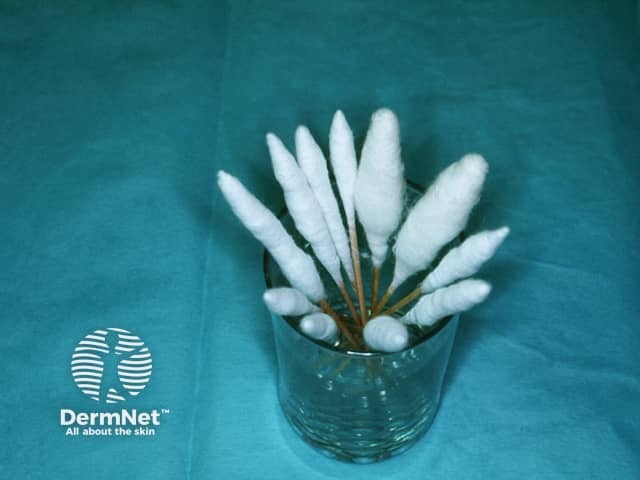
Large cotton swabs used for cryotherapy
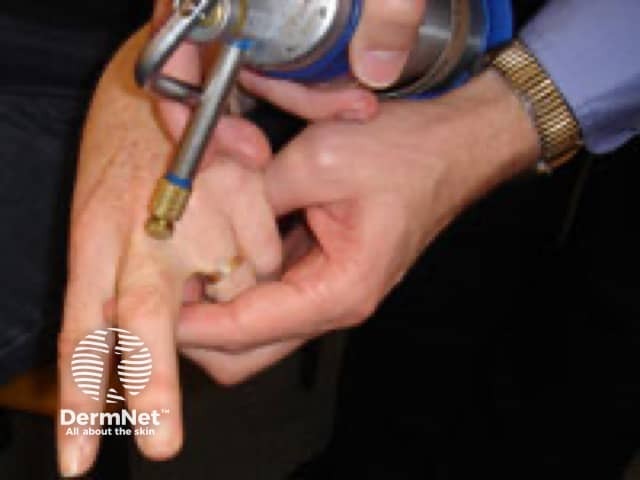
Cryotherapy spray
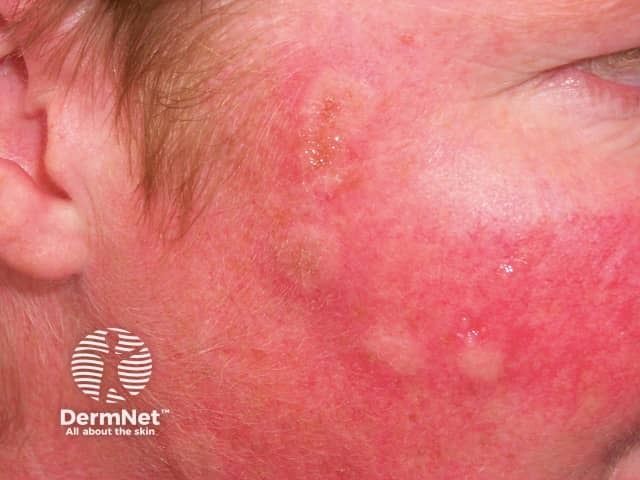
Redness and oedema 4 hrs after cryotherapy
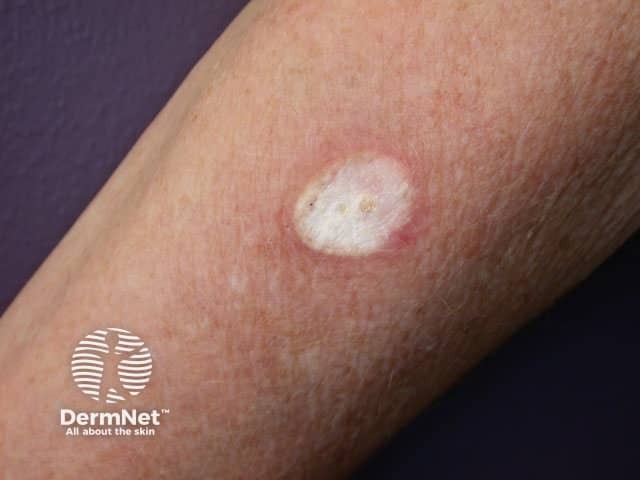
The ice ball just as the cryotherapy is discontinued – it will thaw in 15-30 seconds
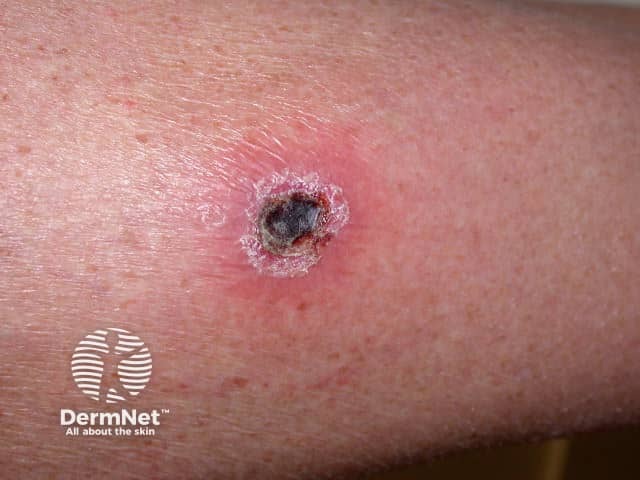
Cryotherapy eschar
Carbon dioxide snow
Carbon dioxide cryotherapy involves making a cylinder of frozen carbon dioxide snow or a slush combined with acetone. It is applied directly to the skin lesion.
DMEP
DMEP comes in an aerosol can and is often available over-the-counter. It is used to treat warts using a foam applicator pushed onto the skin lesion for 10–40 seconds, depending on its size and site.
What are the benefits and disadvantages of cryotherapy?
Cryotherapy is a simple and relatively safe procedure, however, it can require several treatments to work. The resultant pain can also hinder compliance.
Actinic and seborrheic keratoses
Benign lesions secondary to sun damage can be highly amenable to cryosurgery.
- Actinic keratoses often only require one freeze-thaw cycle with complete cure rates varying from 39%– 83%.
- Seborrheic keratoses may require longer treatment times and multiple freeze-thaw cycles if lesions are thicker.
Viral warts
Clearance rates of verrucous lesions can vary depending on the degree of hyperkeratosis and size of the wart.
Several treatment sessions may be needed and the overall cure rate varies from 39% to 84% at three months.
Favourable response rates have been reported with keratolytic pre-treatment.
Malignant lesions: BCCs and SCCs
Cryosurgery is not a first-line treatment for cancerous lesions such as BCCs and SCCs, but is an option for low-risk lesions.
- Malignant lesions typically require multiple freeze-thaw cycles and ice field margins of 3–5mm beyond the lesion.
- Recurrence rates can vary from 6% to 34%, thus requiring regular follow-up as it can be difficult to identify recurrence and achieve margin control.
What are the side effects, risks, and complications of cryotherapy?
Immediate effects
- Pain
- Paraesthesia
- Oedema — periorbital, forehead, lips
- Headache
- Blistering — clear and haemorrhagic

A cryotherapy blister 48 hrs after treatment
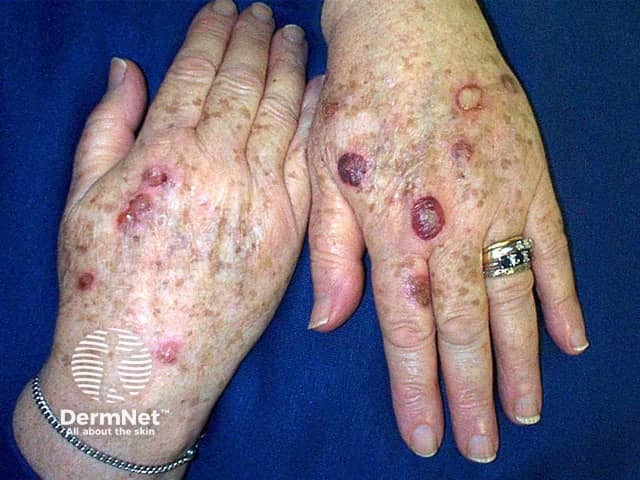
Haemorrhagic blisters 3 days after treatment
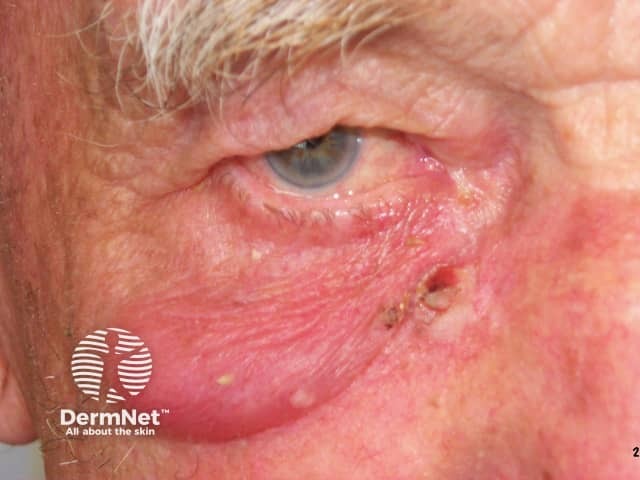
Eyelid oedema 24 hrs after cryotherapy to the lesion adjacent to the nose
Delayed effects
- Bleeding
- Ulceration
Other complications
- Secondary wound infections
- Infection can present as increased pain, swelling, thick yellow blister fluid, purulent discharge, and/or redness around the treated area.
- Treated with topical antiseptics and oral antibiotics.
- Nitrogen emphysema (rare)
- Local nerve damage (usually temporary)
- Permanent hypopigmentation or scar
- Atrophic scarring
- Alopecia
- Persistent or recurrent skin lesions, necessitating further cryotherapy, surgery, or other treatment.
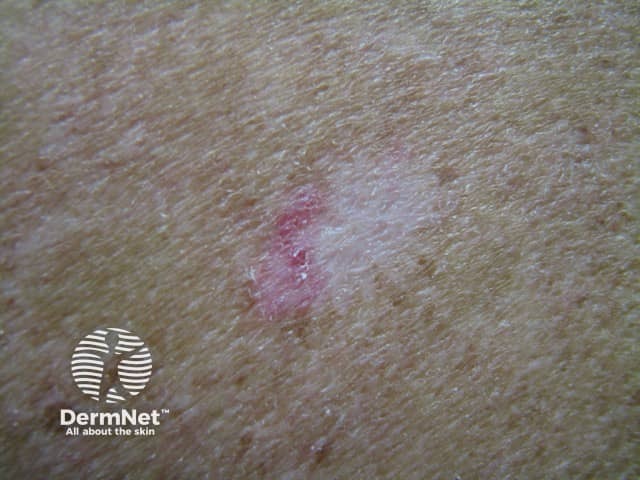
Recurrent BCC post-cryotherapy
Looking after the treated area
It is important to provide patients with postoperative wound care instructions and complications to be aware of.
Usually, no special attention is needed during the healing phase. The treated area may be gently washed once or twice daily with soap and water and should be kept clean. A dressing is optional but is advisable if the affected area is subject to trauma or clothes rub on it.
Immediate swelling and redness may be reduced by:
- A topical steroid applied on a single occasion directly after freezing
- Oral aspirin for inflammation and discomfort.
The treated area is likely to blister within a few hours, depending on the depth and duration of the freeze. It may contain clear fluid or blood (this is harmless).
Treatment near the eye may result in a puffy eyelid, especially the following morning, but the swelling settles within a few days. A scab will then form and the blister gradually dries up.
When the blister dries to a scab, apply petroleum jelly and avoid picking at the scab. The scab peels off after 5–10 days on the face and 3 weeks on the hand. A sore or scab may persist as long as 3 months on the lower leg because healing in this site is often slow.
Bibliography
- Clebak KT, Mendez-Miller M, Croad J. Cutaneous Cryosurgery for Common Skin Conditions. Am Fam Physician. 2020;101(7):399–406. Journal
- Cranwell WC, Sinclair R. Optimising cryosurgery technique. Aust Fam Physician. 2017;46(5):270–4. Journal
- Prohaska J, Jan AH. Cryotherapy. StatPearls. Treasure Island (FL) 2022. Resource
On DermNet
- Liquid nitrogen/cryotherapy guidelines
- Common skin lesions. Non-surgical physical treatments
- Actinic keratoses
- Seborrhoeic keratoses
- Skin tags
- Molluscum contagiosum
- Viral warts
Other websites
- Cryotherapy — British Association of Dermatologists
